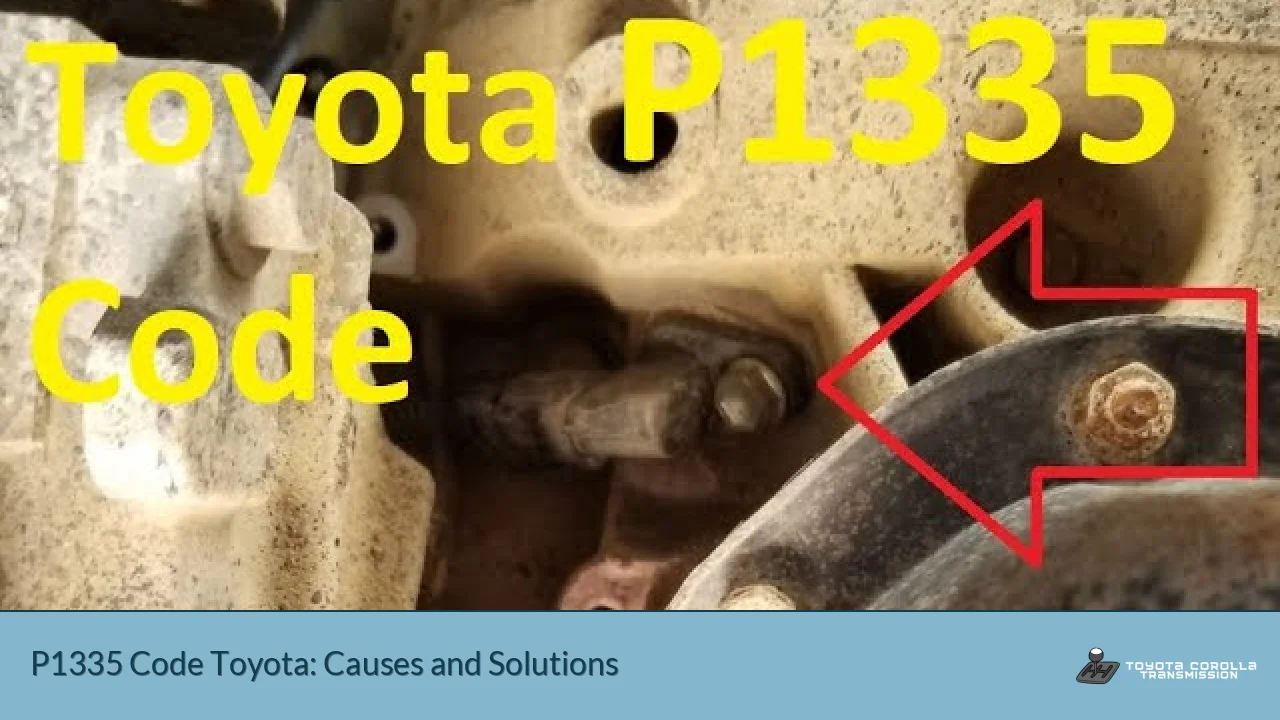When your vehicle’s check engine light illuminates and you retrieve the diagnostic trouble code P1335, you’re dealing with a crankshaft position (CKP) sensor circuit malfunction. This issue, particularly common in Toyota vehicles, can lead to various engine performance problems if left unaddressed. Let’s dive into the details of this fault code, its implications, and how to resolve it effectively.
| Aspect | Description | Severity |
|---|---|---|
| Code Definition | Crankshaft Position Sensor Circuit Malfunction | High |
| Symptoms | Engine misfires, hard starting, stalling | Moderate to Severe |
| Causes | Faulty sensor, wiring issues, ECM problems | Varied |
Understanding the Crankshaft Position Sensor
The crankshaft position sensor plays a crucial role in your engine’s operation. It monitors the position and rotational speed of the crankshaft, providing essential data to the engine control module (ECM). This information is used to:
- Determine ignition timing
- Control fuel injection
- Synchronize the engine’s operations
Location and Function
In most Toyota models, the CKP sensor is located near the crankshaft pulley, often mounted on the oil pan close to the oil filter. It consists of a permanent magnet, core, and coil. As the engine runs, the gap between the sensor and the crankshaft pulley changes periodically, causing voltage fluctuations in the sensor coil. The ECM interprets these signals to detect the top dead center (TDC) and precisely time engine events.
Symptoms of a P1335 Code
When your vehicle triggers a P1335 code, you may experience several symptoms:
- Engine misfires: Irregular engine operation due to improper timing.
- Hard starting: Difficulty in starting the engine, especially when cold.
- Stalling: The engine may shut off unexpectedly, particularly at idle.
- Poor fuel economy: Inefficient engine operation leads to increased fuel consumption.
- Reduced performance: You might notice a lack of power or hesitation during acceleration.
Common Causes of P1335
Several factors can contribute to a P1335 code:
1. Faulty Crankshaft Position Sensor
The most direct cause is often a malfunctioning CKP sensor. Over time, these sensors can wear out or become damaged by heat, vibration, or debris.
2. Wiring Issues
Frayed, corroded, or damaged wiring in the CKP sensor circuit can disrupt the signal. This includes problems with the wiring harness, connectors, or ground connections.
3. ECM Problems
Although less common, issues with the engine control module itself can lead to misinterpretation of the CKP sensor signals.
4. Mechanical Problems
In some cases, mechanical issues like a worn timing belt or chain can cause the CKP sensor to read incorrectly.
Diagnosing the P1335 Code
Proper diagnosis is crucial for effectively addressing the P1335 code. Here’s a step-by-step approach:
- Scan for additional codes: Other related codes might provide more context.
- Visual inspection: Check the wiring and connectors for obvious damage.
- Resistance testing: Measure the resistance of the CKP sensor using a multimeter.
- Signal testing: Use an oscilloscope to verify the sensor’s output signal.
- Component testing: If necessary, test the ECM and other related components.
Fixing the P1335 Code
Once you’ve identified the root cause, here are potential fixes:
1. Replacing the CKP Sensor
If the sensor is faulty, replacement is often the most straightforward solution. Ensure you use a high-quality, OEM-equivalent part for best results.
2. Repairing Wiring
Carefully inspect and repair any damaged wiring. This might involve soldering connections, replacing connectors, or even entire wiring harnesses.
3. Addressing Mechanical Issues
If the problem stems from mechanical issues like a worn timing belt, address these underlying problems to prevent recurrence.
4. ECM Replacement or Reprogramming
In rare cases where the ECM is at fault, it may need reprogramming or replacement. This should be done by a qualified professional.
Preventing Future P1335 Codes
To minimize the risk of encountering this issue again:
- Regular maintenance: Follow your vehicle’s recommended maintenance schedule.
- Keep the engine clean: Prevent debris and oil buildup around the CKP sensor.
- Address issues promptly: Don’t ignore check engine lights or performance issues.
- Quality parts: Use high-quality replacement parts when repairs are necessary.
The Importance of Timely Repairs
Ignoring a P1335 code can lead to more severe problems. The crankshaft position sensor is critical for proper engine timing and operation. Continued driving with a malfunctioning sensor can result in:
- Increased engine wear
- Catalytic converter damage
- Complete engine failure in extreme cases
Therefore, it’s crucial to address this issue as soon as possible to maintain your vehicle’s performance and longevity.
FAQs
What does the P1335 code mean?
The P1335 code indicates a malfunction in the crankshaft position sensor circuit. It suggests issues with the sensor, wiring, or related components.
Can I drive with a P1335 code?
While possible, it’s not recommended. Driving with this code can lead to poor performance, stalling, and potential engine damage.
How much does it cost to fix a P1335 code?
Repair costs vary but typically range from $100 to $500, depending on the cause and whether professional diagnosis is needed.
Can a P1335 code clear itself?
It’s unlikely. While the code might disappear temporarily, it will usually return unless the underlying issue is addressed.
How long does it take to replace a crankshaft position sensor?
Replacement usually takes 1-2 hours, depending on the vehicle model and sensor location.
Conclusion
The P1335 code, while potentially alarming, is a manageable issue when approached systematically. By understanding its causes, symptoms, and solutions, you can effectively diagnose and resolve the problem, ensuring your vehicle’s continued performance and reliability. Remember, when in doubt, consult with a qualified mechanic or Toyota specialist to ensure proper diagnosis and repair.

